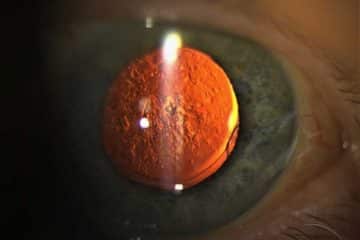Blepharospasm – Overview
Blepharospasm is an abnormal, involuntary blinking or spasm of the eyelids. The condition can appear for a few days and then resolve on its own without treatment, however, in some cases it can progress to a chronic condition causing lifelong vision challenges.
The condition is different from Myokymia, the more common involuntary twitching of the eye that often comes and goes without cause for concern.
In blepharospasm, people have normal eyes but for some time, have great difficulty in opening their eyelids effectively causing functional blindness.
The causes of blepharospasm are a subject of continuous research, however, educated guesses concerning the causes are being made by medical professionals.
Blepharospasm can be caused by some drugs such as those used for estrogen replacement therapy, treatment of Parkinson’s disease, and benzodiazepine. It can also be caused by some diseases such as multiple sclerosis.
Blepharospasm can be treated using drug therapy, botulin toxin injection, and surgical intervention.

blepharospasm
Types of Blepharospasm
There are two types of blepharospasm namely; essential and reflex blepharospasm.
- Benign Essential Blepharospasm (BEB)
This refers to focal dystonia—a neurological movement disorder involving involuntary and sustained contractions of the muscles around the eyes. The term “essential” indicates that the cause is unknown.
It includes flickering of the eyelids and could be linked to apraxia of the eyelid, which is difficulty opening the eyelid.
The condition is bilateral and results in uncontrollable contractions of the eyelids muscle namely orbicularis oculi, procerus, and corrugator muscles resulting in bilateral eye closure.
- Reflex Blepharospasm
This refers to a spasm of the eyelids due to any pain in and around the eye.
Signs and symptoms of Blepharospasm
– Excessive blinking of the eyes: There is an increase in blink frequency and spastic involuntary closure of the eye. This is usually characterized by uncontrollable eyelid closure of durations longer than the typical blink reflex, sometimes lasting minutes or even hours
– Uncontrollable contractions or twitches of the eye muscles: The patient experiences persistent twitching of the eyes. Some sufferers have twitching symptoms that radiate into the nose, face, and sometimes, the neck area
– Dryness of the eyes
– Sensitivity to the sun and bright light
Causes of Blepharospasm
The basal ganglion is the part of the brain responsible for controlling the muscles. Blepharospasm is associated with an abnormal function of the basal ganglion from an unknown cause although educated guesses are been made by medical professionals. Some of the causes of blepharospasm are as follows:
– Drugs: Some drugs have been linked to causing blepharospasms. Drugs used to treat Parkinson’s disease and hormone dysfunction can lead to blepharospasms. Women going through menopause may have some undesired symptoms such as hot flashes, night sweats, vaginal dryness which may necessitate the need for estrogen replacement therapy. Blepharospasm can be a side effect of the drugs used.
Also, prolonged use and sudden withdrawal from Benzodiazepine can cause blepharospasms.
– Multiple Sclerosis: A disease in which the immune system eats away at the protective covering of nerves. Multiple sclerosis can cause blepharospasms.
Other causes of blepharospasms include Dry eye syndrome, Meige’s syndrome, and concussions.
Blepharospasm Treatment
The treatments of Blepharospasm include drug therapy, certain injections, surgery, and neuroplasty and this varies according to the severity of the condition.
Drug Therapy
Drug therapy for blepharospasms has proved generally unpredictable and short-termed. Finding an effective regimen for any patient usually requires trial and error over time. Anticholinergics, tranquilizing drugs and botulinum toxin are the most used therapeutic options.
Botulinum toxin
Botox can be injected into the muscles of eyelids to paralyze them. Among most sufferers, botulinum toxin injection is the preferred treatment method. Injections are generally administered every three months, with variations based on patient response and usually give almost immediate relief (though for some it may take more than a week) of symptoms from the muscle spasms. Most patients can lead a relatively normal life with regular botulinum toxin treatments.
Blepharospasm Surgery
Before surgery is recommended, patients are advised to try safe, potentially efficacious, nonsurgical therapy such as botulinum toxin injections. Functionally impaired patients with blepharospasm who have not tolerated or responded well to medication or botulinum toxin are candidates for surgical therapy.
The surgical removal of the eyelid and brow-squeezing muscles is referred to as a myectomy procedure. The most effective surgical treatment has been protractor myectomy, the removal of muscles responsible for eyelid closure. The procedure can be carried out under local or general anesthesia depending on the surgeon or patient’s choice.
Blepharospasm Surgery Risks and Complications
Like any surgical procedure, there are risks of complications with myectomy. Some of the possible complications are as follows:
- Hematomas – accumulation of blood in the eyelid
- Lymphedema – accumulation of fluid in the tissues
- Numbness of forehead region
- Decreased eyelid closure
- Eyelid swelling
Blepharospasm Surgery Cost
The total cost for blepharospasm surgery depends on a lot of factors such as the anesthetic fee, private hospital fee, private operating facility fee, the extent of surgery required. The total cost of the procedure is around $3500 – $6500.
More: History of Surgery


